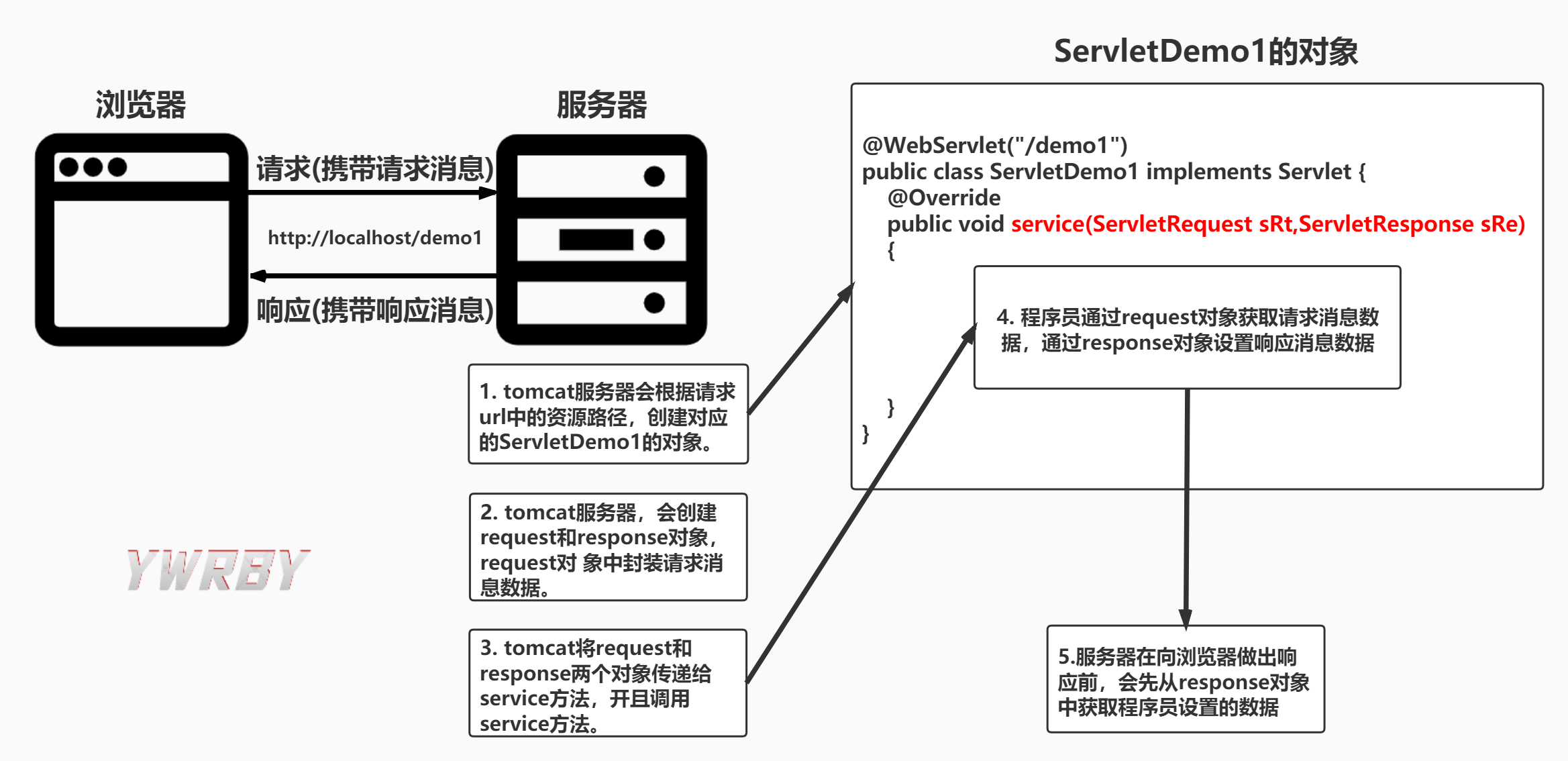Request对象
request对象和response对象原理
- request对象和response对象是由服务器创建的,供程序员使用的对象
- request对象是来获取请求信息的,response对象是来设置响应消息的
浏览器&服务器请求响应过程

Request功能
获取请求消息数据
- 获取请求行数据
- String getMethod():获取请求方式GET/POST
- String getContextPath():获取虚拟目录
- String getServletPath():获取Servlet路径
- String getQueryString():获取get方式的请求参数
- String getRequestURI():获取请求URI(不包含协议和IP地址)
- StringBuffer getRequestURL():获取请求URI(包含协议和IP地址)
- String getProtocol():获取协议及版本
- String getRemoteAddr():获取客户机IP地址
- 获取请求头数据
- String getHeader(String headerName):通过请求头的名称获取请求头的值
- Enumeration getHeaders():获取所有请求头的名称(Enumeration通过hasMoreElements方法判断是否结束,通过nextElement获取下一个请求头的名称)
- 获取请求体数据
- 只有POST请求方式,才有请求体
- 请求体的返回数据是流对象的格式,所以我们需要先获取流对象,再从流对象中获取请求体的数据,共有两种方式获取流对象
- BufferesReader getReader():获取字符输入流,只能操作字符数据
- ServletInputStream getInputStream():获取字节输入流,可以操作所有类型的数据
获取请求行数据代码示例
1
2
3
4
5
6
7
8
9
10
11
12
13
14
15
16
17
18
19
20
21
22
23
24
25
26
27
28
29
30
31
32
33
34
35
36
37
38
39
40
41
|
@WebServlet(value="/requestDemo1")
public class RequestDemo1 extends HttpServlet {
protected void doPost(HttpServletRequest request, HttpServletResponse response) throws ServletException, IOException {
}
protected void doGet(HttpServletRequest request, HttpServletResponse response) throws ServletException, IOException {
System.out.println("请求方式:"+request.getMethod());
System.out.println("虚拟目录:"+request.getContextPath());
System.out.println("Servlet路径:"+request.getServletPath());
System.out.println("get方式的请求参数:"+request.getQueryString());
System.out.println("请求URI:"+request.getRequestURI());
System.out.println("请求URL:"+request.getRequestURL());
System.out.println("协议及版本:"+request.getProtocol());
System.out.println("客户机IP地址:"+request.getRemoteAddr());
}
}
|
获取请求头数据代码示例
1
2
3
4
5
6
7
8
9
10
11
12
13
14
15
16
17
18
| @WebServlet("/requestDemo2")
public class RequestDemo2 extends HttpServlet {
protected void doPost(HttpServletRequest request, HttpServletResponse response) throws ServletException, IOException {
}
protected void doGet(HttpServletRequest request, HttpServletResponse response) throws ServletException, IOException {
Enumeration<String> enumeration=request.getHeaderNames();
while (enumeration.hasMoreElements()){
String headerName=enumeration.nextElement();
String headerValue=request.getHeader(headerName);
System.out.println(headerName+" : "+headerValue);
}
}
}
|
运行结果:(有特殊字符*/不便放在注释中)
1
2
3
4
5
6
7
8
9
10
11
12
| host : localhost:8080
connection : keep-alive
upgrade-insecure-requests : 1
user-agent : Mozilla/5.0 (Windows NT 10.0; Win64; x64) AppleWebKit/537.36 (KHTML, like Gecko) Chrome/84.0.4147.89 Safari/537.36
accept : text/html,application/xhtml+xml,application/xml;q=0.9,image/webp,image/apng,*
|
获取请求体数据示例
1
2
3
4
5
6
7
8
9
10
11
12
13
14
15
16
17
18
| @WebServlet("/requestDemo3")
public class RequestDemo3 extends HttpServlet {
protected void doPost(HttpServletRequest request, HttpServletResponse response) throws ServletException, IOException {
BufferedReader br=request.getReader();
String line=null;
while((line=br.readLine())!=null){
System.out.println(line);
}
}
protected void doGet(HttpServletRequest request, HttpServletResponse response) throws ServletException, IOException {
}
}
|
其他功能
1. 通用的获取请求参数的方法
以下四种方式不论是POST还是GET方式都可以获取到请求参数
- String getParameter(String name):根据参数名称获取参数值
- String[] getParameterValues(String name):根据参数名称获取参数值的数组(因为可能出现一个名称对应多个值的情况)
- Enumeration getParameterNames():获取所有请求参数的名称
- Map<String,String[]> getParameterMap():获取所有参数的map集合
中文乱码问题:
当获取请求参数出现乱码时,只需要在获取参数前,提前设置编码请求参数的格式即可
2. 请求转发功能
一种在服务器内部的资源跳转方式
步骤
- 通过request对象获取请求转发器对象:RequestDispatcher getRequestDispatcher(String path)
- 使用RequestDispatcher对象进行转发,利用其的forward(ServletRequest request ServletResponse response)方法
特点
- 浏览器路径不发生变化
- 只能转发到当前服务器内部资源中
- 转发是一次请求
示例
1
2
3
4
5
6
7
8
9
10
11
12
13
14
15
16
17
| @WebServlet("/requestDemo5")
public class RequestDemo5 extends HttpServlet {
protected void doPost(HttpServletRequest request, HttpServletResponse response) throws ServletException, IOException {
System.out.println("访问RequestDemo5...");
RequestDispatcher requestDispatcher=request.getRequestDispatcher("/requestDemo6");
requestDispatcher.forward(request,response);
}
protected void doGet(HttpServletRequest request, HttpServletResponse response) throws ServletException, IOException {
this.doPost(request,response);
}
}
|
1
2
3
4
5
6
7
8
9
10
| @WebServlet("/requestDemo6")
public class RequestDemo6 extends HttpServlet {
protected void doPost(HttpServletRequest request, HttpServletResponse response) throws ServletException, IOException {
System.out.println("访问RequestDemo6...");
}
protected void doGet(HttpServletRequest request, HttpServletResponse response) throws ServletException, IOException {
this.doPost(request,response);
}
}
|
3. 共享数据
域对象:
一个有作用范围的对象,可以在范围内共享数据
request域:
代表一次请求的范围,一般用于请求转发的多个资源中共享数据
使用方法:
- void setAttribute(String name,Object obj):存储数据
- Object getAttribute(String name):通过键获取值
- void removeAttribute(String name):通过键移除键值对
4. 获取ServletContext对象
BeanUtils工具类
用于简化数据的封装过程
JavaBean
标准的Java类
要求
- 类必须被public修饰
- 必须提供空参的构造器
- 成员变量必须使用private修饰
- 提供公共的setter和getter方法
功能
封装数据
提供的方法
- setProperty
- getProperty
- populate(Object obj,Map map):将map集合的键值对信息,封装到对应的JavaBean对象中
Response对象
功能
设置响应消息(相应行,响应头,响应体)
设置响应行
- 格式:例如 HTTP/1.1 200 OK
- 设置状态码:setStatus(int sc)
设置响应头
- setHeader(String name,String Value)
设置响应体
步骤
- 获取输出流
- 字符输出流:PrintWriter getWriter()
- 字节输出流:ServletOutputStream getOutputStream()
- 使用输出流,将数据输出到客户端浏览器
示例:
1. 重定向
资源跳转的一种方式
特点:
- 重定向后地址栏发生变化
- 重定向可以访问其他站点(服务器)的资源
- 重定向是两次请求,不能使用request对象共享数据
常规重定向操作
- 设置状态码为302
- 设置location响应头,值为重定向资源路径
1
2
3
4
5
6
7
8
9
10
11
12
13
14
| @WebServlet("/responseDemo1")
public class ResponseDemo1 extends HttpServlet {
protected void doPost(HttpServletRequest request, HttpServletResponse response) throws ServletException, IOException {
response.setStatus(302);
response.setHeader("location","/LoginTest/responseDemo2");
}
protected void doGet(HttpServletRequest request, HttpServletResponse response) throws ServletException, IOException {
this.doPost(request,response);
}
}
|
上述重定向操作中不难看出,状态码设为302是固定的,响应头的名称设为location也是固定的,唯一在重定向时会发生变化的就是跳转资源的路径,所以response对象将重定向进行了封装
更简单的重定向操作
1
2
3
4
5
6
7
8
9
10
11
| @WebServlet("/responseDemo1")
public class ResponseDemo1 extends HttpServlet {
protected void doPost(HttpServletRequest request, HttpServletResponse response) throws ServletException, IOException {
response.sendRedirect("/LoginTest/responseDemo2");
}
protected void doGet(HttpServletRequest request, HttpServletResponse response) throws ServletException, IOException {
this.doPost(request,response);
}
}
|
2. 输出字符/字节数据
输出字符/字节数据
- 设置编码格式(防止中文乱码)
- 获取字符/字节输出流
- 输出数据
字符数据代码实现
1
2
3
4
5
6
7
8
9
10
11
12
13
14
15
| @WebServlet("/responseDemo3")
public class ResponseDemo3 extends HttpServlet {
protected void doPost(HttpServletRequest request, HttpServletResponse response) throws ServletException, IOException {
response.setContentType("text/html;charset=utf-8");
PrintWriter pw=response.getWriter();
pw.write("你好!hello world!");
}
protected void doGet(HttpServletRequest request, HttpServletResponse response) throws ServletException, IOException {
this.doPost(request,response);
}
}
|
字节数据代码实现
1
2
3
4
5
6
7
8
9
10
11
12
13
14
15
| @WebServlet("/responseDemo3")
public class ResponseDemo3 extends HttpServlet {
protected void doPost(HttpServletRequest request, HttpServletResponse response) throws ServletException, IOException {
response.setContentType("text/html;charset=utf-8");
ServletOutputStream sos=response.getOutputStream();
sos.write("加油!good job!".getBytes(StandardCharsets.UTF_8));
}
protected void doGet(HttpServletRequest request, HttpServletResponse response) throws ServletException, IOException {
this.doPost(request,response);
}
}
|
路径写法
相对路径
通过相对路径不可以确定唯一资源,相对路径的写法:./index.html
相对路径的规则
绝对路径
通过绝对路径可以确定唯一资源,但在书写时一般不写整个绝对路径的全部内容而是简化写法,例如:http://localhost/JavaWebTest/responseDemo1 可以简化为/JavaWebTest/responseDemo1
绝对路径规则
- 给客户端浏览器使用的路径需要加上虚拟目录,即格式为/JavaWebTest/responseDemo1(例如超链接标签,重定向等等)
- 给服务器端使用的路径不需要加上虚拟路径,即格式为/responseDemo1(例如转发)









